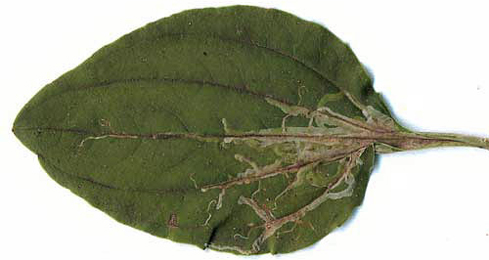|
||||||
|
Phytomyza
griffithsi Spencer, 1963 Phytomyza
griffithsi
Spencer, 1963d. Stuttg. Beitr. Naturk. No. 103:
1-2, figs 1a-1d |
|||||||||||||||||||||||||||||||||||||||||||
Leaf-miner: Mine initially lower surface, but largely on upper surface, irregularly linear, finally almost filling the petiole and ending at the base. Pupation within the petiole (Spencer, 1972b: 84, 85 (fig. 275A)). Several eggs are deposited on the blade. From there narrow corridors descend in the direction of the petiole. Once they have arrived there, the larvae start making broad lobate corridors that fan out over the basal half of the leaf. Later parts of the mine are party upper-surface, partly interparenchymatous, looking pale green. In the shallow parts primary feeding lines often visible. Frass in widely dispersed grains. According to Buhr (1964a) older mines often turn black. Pupation within the mine, often in the petiole. Puparium generally at the lower surface; the anterior spiracles penetrate the epidermis (Bladmineerders van Europa).
Larva: The larvae of flies are leg-less maggots without a head capsule (see examples). They never have thoracic or abdominal legs. They do not have chewing mouthparts, although they do have a characteristic cephalo-pharyngeal skeleton (see examples), usually visible internally through the body wall. Puparium: The puparia of flies are formed within the hardened last larval skin or puparium and as a result sheaths enclosing head appendages, wings and legs are not visible externally (see examples). Posterior spiracular process only slightly raised (Spencer, 1972b: 84). White (Bladmineerders van Europa). Hosts in Great Britain and Ireland:
Time of year - mines: June. Time of year - adults: July. Distribution in Great Britain and Ireland: Uncommon. Surrey (Box Hill) (Spencer, 1963d: 1-2). Distribution elsewhere: Widespread in continental Europe including Germany (Spencer, 1963d: 1-2; Spencer, 1990: 212), The Netherlands (Bladmineerders van Europa), Czech Republic, Lithuania and Poland (Fauna Europaea). NBN Atlas links to known host species: British and Irish Parasitoids in Britain and elsewhere:
|
|
|
|
| External links: | Search the internet: |
| Biodiversity Heritage Library Bladmineerders van Europa British leafminers Encyclopedia of Life Fauna Europaea NBN Atlas NHM UK Checklist |
Find
using Google Find using Google Scholar Find images using Google |
| Last updated 10-Jul-2019 Brian Pitkin | ||

